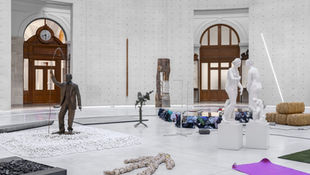
Aesthetic Mediations and the Social Geography of Villa Brooks
Henri Matisse’s encounter with Tangier in 1912 has long been seen as pivotal in his journey towards a flatter, more abstract pictorial language. Yet the full context of his experience in Morocco - and particularly the production of his three "decorative landscapes" - has remained under-explored. Often positioned within broader discourses of Orientalism, these works have typically been interpreted as either aesthetic responses to the Moroccan environment or imaginative reconstructions of exoticised space. This article revisits Matisse’s Tangier paintings through newly discovered visual and textual materials, shedding light on the heterotopic landscape of the Villa Brooks garden and the social mechanisms through which the artist accessed and transformed that space. These findings enrich our understanding of Matisse not simply as a modernist responding to colour and form, but as a socially embedded figure navigating the entanglements of empire, class, and artistic identity.

At the turn of the 20th century, Tangier was a node of geopolitical tension and multicultural exchange. Its unique status as an international zone attracted diplomats, adventurers, artists, and entrepreneurs. For European visitors, Tangier embodied both danger and allure - a borderland at the edge of Africa and Europe, where Islam and Christianity, modernity and tradition, converged. Within this context, the garden of Villa Brooks, or Senya el Hashti, emerged as a symbolically loaded microcosm: a carefully cultivated Anglo-Moroccan enclave that stood as much for imperial nostalgia as for botanical retreat. Owned by Captain John Hay Brooks, a retired British officer with strong ties to local and expatriate elites, Villa Brooks was a space of European privilege that maintained a delicate relationship with its Moroccan setting. The garden itself, with its terraced paths, Mediterranean flora, and borrowed Islamic motifs, was a hybrid landscape shaped by colonial aesthetics. For Matisse, this space offered both privacy and artistic inspiration, yet it was also dense with political and cultural significance.
Matisse’s access to Villa Brooks was neither incidental nor accidental. Recently uncovered correspondence indicates that his entrée into this exclusive Anglo-Moroccan world was facilitated by British artistic and diplomatic networks. The painter’s growing reputation in the European art world had brought him into contact with collectors and cultural intermediaries who moved fluidly between Paris, London, and Tangier. These individuals, in turn, were instrumental in securing Matisse’s permission to work in the garden of Villa Brooks, a space otherwise closed to the public. Photographs from 1912, hitherto unpublished, show Henri and Amélie Matisse strolling through the grounds of the villa. Their appearance there, far from being a spontaneous occurrence, was the result of careful negotiation and positioning within a transnational art market increasingly shaped by elite connections and colonial mobility.

The three "decorative landscapes" Matisse produced during his time at Villa Brooks - Landscape Viewed from a Window, Window at Tangier, and The Garden at Villa Brooks - are marked by a formal shift toward planar colour, pattern, and abstraction. Unlike the overt Orientalism of some of his contemporaries, Matisse’s works from this period resist narrative or ethnographic content. They instead foreground structure and sensation, reducing the garden to a rhythmic interplay of lines and chromatic fields. Yet the ambivalence in these paintings is striking. While they lack the figurative Orientalist tropes common in early 20th-century French representations of North Africa, they do not reject exoticism entirely. Rather, Matisse seems to abstract the "exotic" into compositional and chromatic terms. His decorative impulse, far from being apolitical, becomes a form of visual negotiation: the imposition of modernist order onto a culturally complex and politically charged site.
To understand the significance of these landscapes, it is useful to draw on Michel Foucault’s concept of the heterotopia - a real space that functions in non-hegemonic ways, simultaneously reflecting and subverting the world outside it. Villa Brooks, as an aristocratic enclave in colonial Tangier, operated as a heterotopia par excellence: a site of European privilege that mirrored and displaced both metropolitan and colonial realities. Matisse’s use of this space and his transformation of it into decorative abstraction can thus be read as an artistic engagement with heterotopia. The result is not a direct representation of Moroccan space but a mediated visualisation of a layered, intercultural terrain. The discovery of new documents - photographs, maps, and letters - fundamentally reshapes our understanding of Henri Matisse’s 1912 sojourn in Tangier. Far from being a mere exotic interlude, this period was marked by deliberate navigations of privilege, spatial politics, and artistic strategy. The decorative landscapes that emerged from Villa Brooks are not simply aesthetic exercises but products of a specific cultural milieu: a heterotopic Anglo-Moroccan garden shaped by empire, tragedy, and European aspirations. Matisse’s work here stands not only as a milestone in the history of modernism but also as a revealing case study in the interrelation of art, power, and place.





